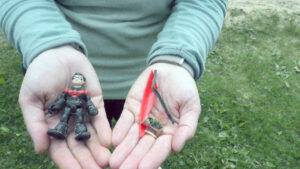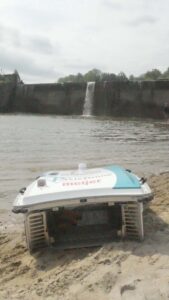
CLEVELAND — Lake Erie is the shallowest and smallest of the five Great Lakes. It is also the most polluted.
In the early 1900s, Lake Erie was a major source of drinking water and recreation for the people who lived along its shores. By the 1960s, the lake had become heavily polluted.
By 1969, the Cuyahoga River, which flows into Lake Erie, had caught fire, which led to the passage of the Clean Water Act in 1972. The Clean Water Act has helped to reduce pollution in Lake Erie, but the lake is still not as clean as it once was.
Part of the pollution problem is plastic. Twenty-two million pounds of plastic enter all of the Great Lakes each year; however, about half of that goes into Lake Erie.

Recently, two trash removal devices were purchased to fight against plastics, small pieces of contaminants, and general litter. One is for the water, and the other is for the sand. The robots are efficient, effective, and environmentally friendly, and they are a valuable tool for cleaning up Lake Erie and other waterways.
The new machine technology that sifts through sand is called a BeBot and is a remote-controlled robot that can rake the sand and collect plastic litter, cans, food wrappers, cigarettes or plastic toys. It can go about 2 to 4 inches deep in the sand, sift through particles, and capture anything bigger than about 4 mm in size, or the thickness of a plastic ID card.

The Pixie Drone is the other technology that will be deployed to help clean up the lake and waterways. It is able to remove trash from areas that are difficult or dangerous for people to access in the water, and it can do it quickly and efficiently. It can pick up to 200 pounds of trash before it needs to be emptied.
Jill Bartolotta, extension educator with the Ohio Sea Grant College Program, is very excited to have these new devices available for not only cleaning up the lake, but there will be students who will be trained for this work. She says that Cuyahoga Community College students will eventually put together a training manual and career materials for this new technology.
Eight partners have come together to clean up Lake Erie and purchase these robots. It was a collaboration of the Great Lakes Plastic Cleanup, Meijer grocery store, the Council of the Great Lakes Region, Ohio Sea Grant, Cleveland Metroparks, Lake Metroparks, Eriesponsible, and Cuyahoga Community College. According to Bartolotta, it is a step in the right direction toward combating the region’s pollution problem and securing a more sustainable future.

“It will have significant impact,” says Bartolotta, “and they have the potential to make a real difference because this technology is environmentally friendly.”
Both devices are solar-powered and battery-operated, so they can operate for long periods of time without needing to be plugged in. Additionally, the BeBots and Pixie Drones are equipped with cameras and sensors that allow them to avoid obstacles. They are also easy to use and can be operated by a single person.
“The Great Lakes basin is the largest freshwater system in the world. Keeping this vital water resource clean and free of litter is essential,” said Lora Shrake, senior program director for business and sustainability at The Council of the Great Lakes Region.
The devices are manufactured in Europe by Searial Cleaners, which is located in France. The company adheres to a strategy to expand environmental solutions for all of the world’s water.









